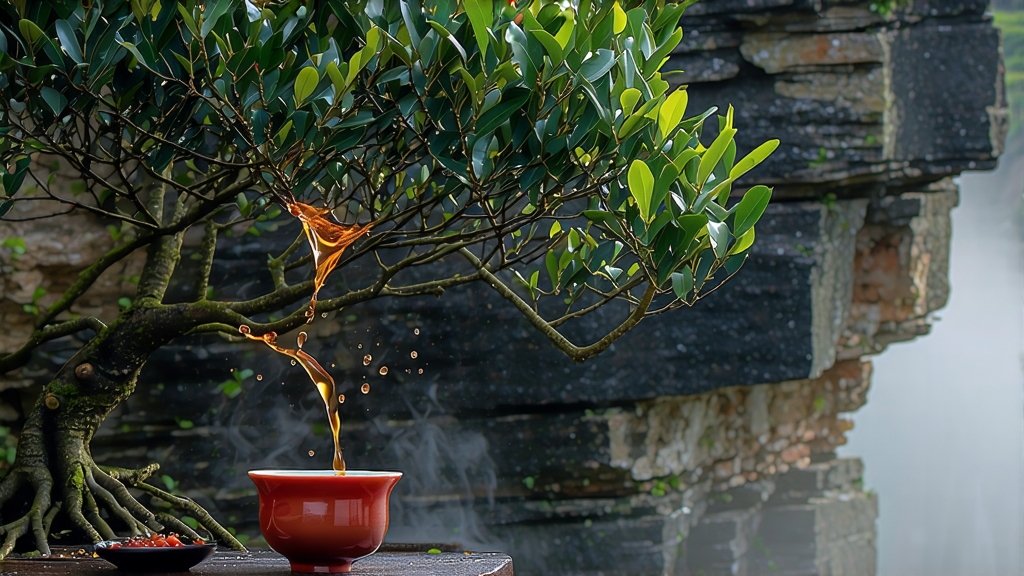
High above the winding Nine-Bend Stream of northern Fujian, the vertical cliffs of Mount Wuyi trap humid mists that have nourished tea trees since the Song dynasty. Among the six major families of Chinese tea, oolong occupies the most dramatic ecological niche, and within that family Da Hong Pao—“Big Red Robe”—stands as the undisputed monarch. International drinkers often meet it first through glossy gift tins or airport boutiques, yet the true leaf is shy, demanding cliff-side soil, midnight charcoal, and a patient hand that can read the language of smoke and stone.
Legend fixes the birth of Da Hong Pao in the late Ming. A scholarly candidate, on his way to the capital examinations, collapsed with fever at the foot of Tianxin Rock. Monks from the nearby Yongle Temple brewed leaves picked from three ancient bushes growing out of a narrow fissure; the scholar revived, continued north, and returned a year later draped in the vermillion silk robe of imperial honor. In gratitude he wrapped his robe around the bushes, giving the tea its name and crimson aura. Whether myth or marketing, the story encodes two truths that still govern the tea: it is medicine for the spirit, and its value is inseparable from the perilous geography that produces it.
Today the original mother trees—six shrubs wedged into a cleft at Jiulongke, guarded by cameras and myth—no longer contribute to commerce. Since 2006 the government has forbidden picking, turning them into a living monument. Yet the name Da Hong Pao is not trademarked; it functions as a collective banner for three distinct lineages.
First comes Pure-Origin Da Hong Pao, cuttings vegetatively propagated from the mother trees and grown inside the 60 km² Wuyi Scenic Area. Micro-terroirs here are sliced by ravines that face every cardinal direction; a 200-meter horizontal walk can flip humidity, temperature, and mineral uptake. Tea makers map these microlots the way Burgundians map crus, speaking of “upper Ma Tou” versus “lower Hui Yuan.” Second is Blended (or Commercial) Da Hong Pao, where leaves from selected Wuyi cultivars—most often Qi Dan, Bei Dou, and Que She—are skillfully married to recreate the aromatic silhouette of the original. A master blender tastes through hundreds of batches, chasing the elusive “rock rhyme” that fuses orchid fragrance with a wet-stone minerality. Finally there are the Named Clones, single-cultivar expressions such as “Qi Dan No.1” or “Bei Dou No.2,” each legally registered and genetically fingerprinted, offering a telescope into the genome of the mother bush without the romantic price tag.
Craft begins in the cool dawn of late April. Pickers climb bamboo scaffolding lashed to the cliff, plucking the standard “zhong kai mian” leaf set—three half-mature leaves and the terminal bud. Once baskets descend by rope, the leaves are spread on bamboo trays and withered under the mountain wind, a process that can last from two hours in dry weather to an entire night if mist lingers. Oxidation is initiated by repeated yaoqing: the trays are stacked and shaken with a wrist motion that bruises the leaf margins while keeping the veins intact. Masters listen for a rustle that sounds like distant rain on banana leaves; when the aroma shifts from cut grass to ripe peach, firing must begin.
What follows is the most theatrical act in Chinese tea making: charcoal roasting inside squat, brick kilns. A hardwood fire of local bayberry and pine is allowed to burn down to embers, then covered with a thick layer of ash so that heat exhales slowly through pin-prick vents. Woven bamboo sieves, each holding no more than 400 g of leaf, are slid onto racks 60 cm above the coals. Every 30 minutes the tea is removed, cooled, and reloaded, a cycle repeated four to eight times depending on the desired style. A “light fire” (qing huo) preserves floral top notes and pale liquor, while a “full fire” (zu huo) drives moisture below 3 %, gifting the leaf a black-bronze sheen and a cocoa depth that will continue to refine for years. Between roastings the tea sleeps in earthen jars, allowing internal moisture to migrate outward, preventing the sourness that novices mistake for the terroir itself.
To brew Da Hong Pao well is to balance its dual nature: it is both sturdy cliff warrior and